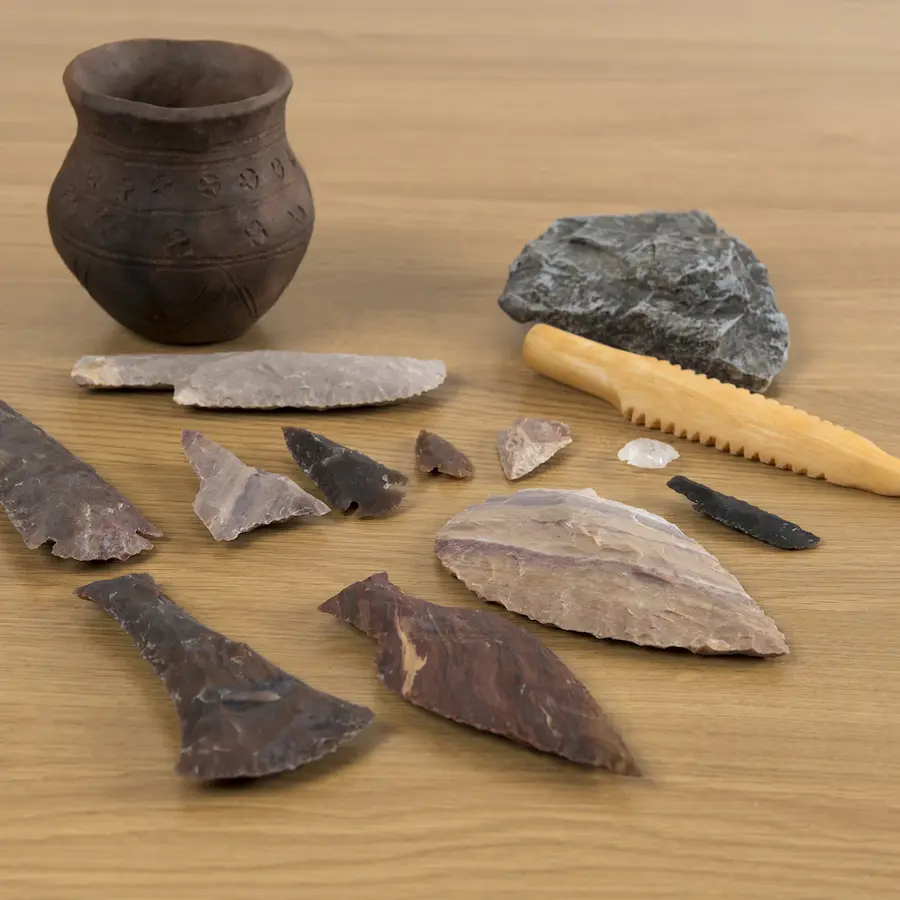
The Paleolithic Era, or ‘Old Stone Age,’ marks the dawning of human history. Spanning from about 2.6 million to 10,000 years ago, this pivotal period saw the first use of tools, the beginnings of art, and the birth of a nomadic lifestyle. In this comprehensive guide, we delve into the era that laid the foundations for civilization. Uncover the mysteries of early human life as we explore their survival strategies, cultural expressions, and the technological innovations that propelled our ancestors forward. From the intricacies of their daily lives to the monumental shifts in environmental adaptations, the Paleolithic Era offers invaluable insights into humanity’s resilience and ingenuity. Join us as we embark on a journey back in time, piecing together the lives of our earliest ancestors through the lens of the Paleolithic Era—the first chapter in the grand narrative of human history.
Defining the Paleolithic Era
The Paleolithic Era, defined by the advent of the first manufactured stone tools, stands as the longest phase of humanity’s history. This epoch is characterized by the development of basic chipped stone tools and covers an extensive period from about 2.6 million years ago until the introduction of agriculture around 10,000 years ago. During this vast stretch of time, our ancestors, including Homo habilis and Homo erectus, began a journey of evolutionary and technological advancement that would pave the way for modern Homo sapiens.
This era is divided into three periods: Lower, Middle, and Upper Paleolithic, each marking significant milestones in human development. The Lower Paleolithic witnessed the rise of tool use and the mastery of fire. The Middle Paleolithic era hosted the development of more sophisticated flint tools and the emergence of Neanderthals. In the Upper Paleolithic, modern humans flourished, bringing forth advanced tools, art, and a complex social structure.
The Paleolithic period is more than just a timeline; it is the story of humanity’s ability to adapt, innovate, and survive in a world that was constantly changing. Through these millennia, our species sculpted the Earth’s landscape with stone tools, leaving a legacy that defines the very essence of human ingenuity and resilience.
Subsistence and Economy
During the Paleolithic Era, subsistence came primarily from hunting and gathering, shaping not just the diet but the entire economic structure of early human societies. The era’s name itself—stemming from Greek words ‘palaios’ (old) and ‘lithos’ (stone)—highlights the basic stone tools that were essential for survival, used in acquiring and preparing food.
Hunter-gatherers followed the migrations of animals and seasonal growth patterns of plants, leading to a nomadic lifestyle. This constant movement in search of food required a deep understanding of the environment, animal behaviors, and plant cycles. Men typically hunted large game using tools like spears and later bows and arrows, while women and children gathered fruits, nuts, and vegetables, providing a balanced diet.
This division of labor was crucial and reflects a cooperative economic system where sharing was vital for the group’s survival. There was no concept of personal property as we understand it today; resources were communal, and the idea of wealth accumulation was nonexistent. Such an egalitarian system meant that food and resources were distributed according to need, minimizing inequality within these early human groups.
The economy of the Paleolithic people also included the first instances of trade. While rudimentary, these exchanges allowed different groups to obtain resources that were scarce in their own territories, such as certain types of stone for tool-making, or shells and pigments used for personal adornment.
In essence, the Paleolithic economy was deeply intertwined with the environment and was marked by its sustainability and reliance on the natural world. This period lays the groundwork for our understanding of pre-agricultural human societies, revealing the adaptive nature of our species in the face of a world that was unpredictable and often unforgiving.
Technological Innovations
The technological innovations of the Paleolithic Era were pivotal in the progression of human societies. Starting with the most primitive stone flakes, our ancestors embarked on an inventive journey that would lead to the development of sophisticated tools and methods essential for survival.

The earliest known stone tools, known as the Oldowan toolkit, appeared around 2.6 million years ago. These were simple pebbles with a few flakes chipped off to create a cutting edge. As the era progressed, the Acheulean hand axe came into use, a bifacial tool with a more refined and symmetrical shape, showcasing a leap in cognitive ability and manual dexterity.
Spearpoints and arrowheads later became hallmarks of the Middle and Upper Paleolithic toolkits, indicating advancements in hunting technology. This era also witnessed the creation of composite tools, where multiple materials such as wood, bone, and stone were combined to produce more complex implements.
The controlled use of fire was another revolutionary achievement of this period. It provided warmth, protection, and a means to cook food, which not only made it safer to eat but also easier to digest, fueling the development of the brain.
Moreover, the Upper Paleolithic Era saw the birth of indirect percussion and pressure flaking techniques, allowing for the production of fine blades and microliths. These innovations were not merely functional but also paved the way for the development of symbolic and artistic expression, as seen in the intricate carvings and beads that have been unearthed.
Thus, the Paleolithic period’s technological innovations lay the groundwork for future societal developments and demonstrate the incredible ingenuity of early humans in adapting to their environment.
Art and Culture
The Paleolithic era witnessed the dawn of art and culture, with the earliest known artistic expressions dating back to around 40,000 years ago. Cave paintings, such as those found in Lascaux, France, display a rich tapestry of life, with images of animals, humans, and abstract symbols. These works not only add beauty to their surroundings but also serve as records of prehistoric life, suggesting that they may have played a role in ritualistic or communicative practices.
Sculptures and carvings, often of ivory or bone, reveal a sophistication in handling materials and an understanding of three-dimensional form. Venus figurines, which represent the female form, are widespread and indicate a shared cultural symbolism across vast distances. Similarly, the production of musical instruments like flutes suggests a cultural appreciation for melody and rhythm.
In sum, the art and culture of the Paleolithic period illustrate the complexity of early human societies and their capacity for abstract thought and expression, providing us with a window into the lives and minds of our ancestors.
Social Structure and Habitation
The social structure of Paleolithic communities was likely shaped by the necessities of a hunter-gatherer lifestyle, fostering a system based on cooperation and mobility. Small bands or tribes, typically consisting of extended family groups, were the fundamental social units. These groups needed to be small enough to move effectively yet large enough to ensure survival through mutual support and resource sharing.
Habitation during the Paleolithic was often temporary and mobile, adapting to the migratory patterns of game and the seasonal availability of plants. Dwellings ranged from simple lean-tos and rock shelters to more complex structures in later periods, like the mammoth bone huts found in present-day Russia and Ukraine.
The transient nature of these early humans influenced their social dynamics, with a fluid hierarchy and roles dictated more by skill and age rather than any rigid status. This mobile way of life underpinned the development of human networks and cultural exchange, laying the foundations for increasingly complex social structures.
Environmental Adaptations
The success of Paleolithic humans hinged on their ability to adapt to a variety of environments, from the ice-bound landscapes of the glacial periods to the warmer climes when the ice retreated. Mastery over fire enabled them to withstand cold temperatures and populate regions previously uninhabitable. Clothing made from animal hides further aided their endurance against harsh weather.
Their tool-making skills were instrumental in adapting to different ecosystems, whether crafting fishing spears suitable for riverine environments or developing hunting strategies for open plains. Nomadic by necessity, these early humans followed the ebb and flow of the seasons, moving to where food was abundant.
Paleolithic humans’ adaptability also extended to their diet. They foraged widely, consuming a diverse range of foods that varied with the locale—from marine resources along coastlines to game in the forests, demonstrating a remarkable ability to thrive across the planet’s varied landscapes.
The Transition to the Neolithic
The transition from the Paleolithic to the Neolithic period, also known as the Neolithic Revolution, marks one of the most significant shifts in human history. This era, beginning around 10,000 years ago, saw nomadic hunter-gatherers settling down to cultivate crops and domesticate animals. The sedentary lifestyle led to the establishment of permanent villages, which evolved into complex societies and eventually, the first urban centers.
Innovations in agricultural technology, such as the plow and irrigation, increased food production, which supported larger populations. Social structures became more complex, with the division of labor and the rise of a ruling class. The surplus of food allowed some community members to pursue non-agricultural professions, leading to the specialization of crafts and trades.
The Paleolithic era’s emphasis on adaptation was not lost but rather redirected, as humans began to shape their environment more intensively than ever before. This pivotal transformation laid the foundation for the development of civilization as we know it.
Conclusion
The Paleolithic Era, a testament to human endurance and ingenuity, set the stage for all subsequent human development. It was a time of profound evolutionary and cultural changes, where early humans mastered the art of survival through tool-making, environmental adaptation, and social cooperation. Their legacies, from the earliest flint tools to the magnificent cave paintings, are milestones that highlight our shared history. As we transitioned into the Neolithic period, these achievements became the building blocks of modern society. Reflecting on this age of beginnings, we gain not only knowledge of our past but also an appreciation for the journey of humanity.
Q&A:
what does paleolithic period mean?
The term “Paleolithic period” comes from two Greek words: “palaios,” meaning “old,” and “lithos,” meaning “stone.” Hence, Paleolithic literally means “Old Stone [Age].” It refers to the earliest period of human history, characterized by the creation and use of stone tools. This era is part of the larger Stone Age, which also includes the Mesolithic and Neolithic periods.
The Paleolithic period spans a vast time, beginning roughly 2.6 million years ago with the first tool-making hominids and ending around 10,000 years ago with the advent of agriculture. It is traditionally divided into three phases:
- Lower Paleolithic (about 2.6 million to 300,000 years ago): The earliest phase, associated with the first stone tools and the rise of the genus Homo.
- Middle Paleolithic (about 300,000 to 30,000 years ago): Marked by the development of more advanced flake tools and the presence of Neanderthals and early modern humans.
- Upper Paleolithic (about 30,000 to 10,000 years ago): Characterized by a significant increase in the diversity of tools, the emergence of art, and complex social structures among modern Homo sapiens.
The Paleolithic period is significant because it captures the longest stretch of human history, during which early humans adapted to changing environmental conditions, developed primitive cultures, and spread across the globe.
What is a Characteristic of the Paleolithic Period?
A quintessential characteristic of the Paleolithic period is the use of stone tools. Early humans in this era crafted a range of implements, from simple choppers to complex hunting weapons, which revolutionized their interaction with the environment. This period is also marked by a nomadic hunter-gatherer lifestyle, where social structures were based on kinship and cooperation, essential for survival in varied and often harsh prehistoric landscapes. Cultural development is evident in the creation of cave art and musical instruments, reflecting the cognitive and social sophistication that arose during this time.
